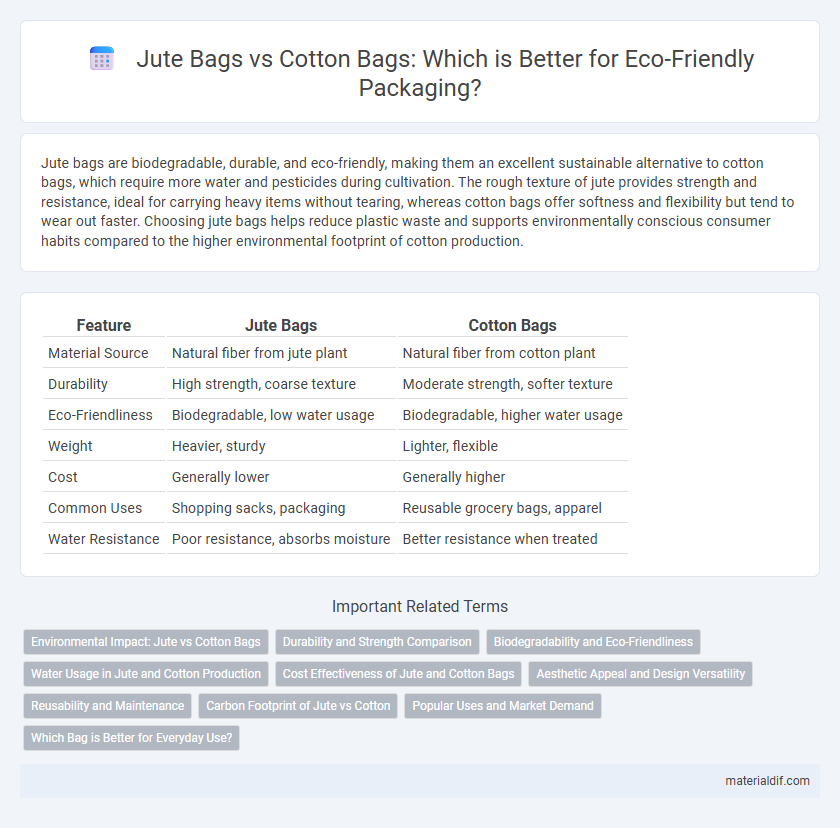Jute bags are biodegradable, durable, and eco-friendly, making them an excellent sustainable alternative to cotton bags, which require more water and pesticides during cultivation. The rough texture of jute provides strength and resistance, ideal for carrying heavy items without tearing, whereas cotton bags offer softness and flexibility but tend to wear out faster. Choosing jute bags helps reduce plastic waste and supports environmentally conscious consumer habits compared to the higher environmental footprint of cotton production.
Table of Comparison
| Feature | Jute Bags | Cotton Bags |
|---|---|---|
| Material Source | Natural fiber from jute plant | Natural fiber from cotton plant |
| Durability | High strength, coarse texture | Moderate strength, softer texture |
| Eco-Friendliness | Biodegradable, low water usage | Biodegradable, higher water usage |
| Weight | Heavier, sturdy | Lighter, flexible |
| Cost | Generally lower | Generally higher |
| Common Uses | Shopping sacks, packaging | Reusable grocery bags, apparel |
| Water Resistance | Poor resistance, absorbs moisture | Better resistance when treated |
Environmental Impact: Jute vs Cotton Bags
Jute bags offer a significantly lower environmental impact compared to cotton bags due to their faster growth rate and minimal need for pesticides or fertilizers. The water consumption for producing jute is substantially less, reducing strain on freshwater resources. Biodegradability and carbon sequestration properties further position jute as a more sustainable choice in eco-friendly packaging.
Durability and Strength Comparison
Jute bags boast higher tensile strength and durability compared to cotton bags, making them ideal for heavy-duty use and carrying bulkier items. The natural lignin content in jute fibers enhances resistance to wear and tear, while cotton fibers tend to weaken faster under stress and frequent washing. This superior durability and sturdiness make jute bags a more sustainable and long-lasting option for eco-friendly packaging solutions.
Biodegradability and Eco-Friendliness
Jute bags exhibit superior biodegradability compared to cotton bags, decomposing naturally within months without leaving harmful residues. Their eco-friendly cultivation requires less water, pesticides, and synthetic fertilizers, reducing environmental impact significantly. Cotton bags, while reusable, often involve intensive water use and chemical inputs in production, making jute a more sustainable choice for environmentally conscious consumers.
Water Usage in Jute and Cotton Production
Jute cultivation requires approximately 50% less water compared to cotton production, making it a more water-efficient crop. Cotton typically consumes about 10,000 liters of water per kilogram, whereas jute demands only around 2,500 liters per kilogram. This significant reduction in water usage positions jute bags as a more sustainable alternative to cotton bags in terms of environmental impact.
Cost Effectiveness of Jute and Cotton Bags
Jute bags offer greater cost effectiveness compared to cotton bags due to lower raw material and production expenses, making them an economical choice for bulk purchases and promotional use. While cotton bags provide durability, their higher cultivation and processing costs increase retail prices, impacting affordability. Choosing jute bags supports budget-conscious consumers seeking sustainable and biodegradable options without compromising functionality.
Aesthetic Appeal and Design Versatility
Jute bags boast a distinct rustic aesthetic and natural texture that enhances their eco-friendly appeal, often favored in artisanal and vintage-inspired designs. Cotton bags offer greater design versatility with a smoother surface that accommodates intricate prints, vibrant colors, and custom patterns, making them popular for fashion-forward and promotional use. The choice between jute and cotton bags depends on the desired look: organic and earthy elegance versus flexible and colorful customization.
Reusability and Maintenance
Jute bags offer superior durability and reusability due to their strong natural fibers, making them ideal for repeated use without significant wear. Maintenance of jute bags is relatively simple, requiring minimal washing and quick drying to prevent mold, whereas cotton bags demand more frequent washing and careful handling to avoid shrinkage and fabric damage. The eco-friendly nature and robust structure of jute contribute to longer lifespan and better sustainability compared to cotton alternatives.
Carbon Footprint of Jute vs Cotton
Jute bags have a significantly lower carbon footprint compared to cotton bags due to the minimal use of water, pesticides, and synthetic fertilizers during jute cultivation. Lifecycle assessments show jute emits approximately 0.95 kg CO2-equivalent per kilogram, whereas cotton generates around 3.06 kg CO2-equivalent per kilogram. This makes jute a more sustainable choice for eco-friendly packaging and reduces overall greenhouse gas emissions.
Popular Uses and Market Demand
Jute bags are widely favored in the packaging and retail industries due to their biodegradable nature and durability, making them ideal for grocery shopping, promotional giveaways, and eco-friendly packaging. Cotton bags, prized for their softness and reusability, dominate the fashion and apparel markets, often used for tote bags and customizable merchandise. Market demand for jute bags is increasing rapidly in regions focusing on sustainable alternatives, while cotton bags retain strong popularity in urban areas where style and fabric versatility drive consumer preference.
Which Bag is Better for Everyday Use?
Jute bags offer superior durability and biodegradability compared to cotton bags, making them ideal for everyday use with heavy loads and eco-friendly preferences. Cotton bags, while softer and easier to clean, tend to wear out faster and require more water-intensive production. Choosing jute bags supports sustainability through natural fiber strength and reduced environmental impact in daily activities.
Jute Bags vs Cotton Bags Infographic

 materialdif.com
materialdif.com